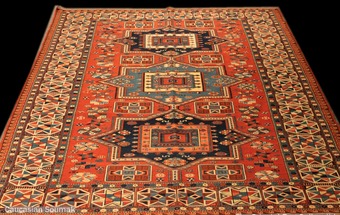Handmade oriental carpet No. 63199 Soumak Caucasus 239 x 177 cm

Larger images (will open in new window)
Please click on the thumbnails below for a larger view
| main view |
close-up |
close-up of corner |
close up of detail |
close-up of another detail |
 |
 |
 |
 |
 |
| Item Number: |
63199 |
| Name: |
Soumak |
| Country of Origin: |
Caucasus |
| Size: |
239 x 177 cm |
| Made:
|
ca. 2000 |
Foundation
(warp and weft): |
wool (this is a flatweave without pile) |
| Design: |
geometric / allover |
| Ground Color: |
rust / red / blue |
| Remarks: |
This is a unique handmade / hand-knotted / traditional oriental flatweave
Akstafa Soumak in perfect condition |
 add to cart
add to cart
This piece is a Kilim. What is a Kilim? "Kilim" is a generic term for all Oriental rugs which have no pile (also Palas, Sumakh, Sileh, Verneh..) therefore being flat weave. Kilims serve nomads as an isolating and decorative floor covering or blanket in their tents. Many Kilims are as well used as prayer rugs kneeing on them in order to pray towards Mekka 5x a day ("the prayer rug of the modest man"). Due to the technique of their making Kilims almost always have generous geometric designs. In case of a floral design it is mostly strongly stylized. Altogether Kilims are beautiful pile-less rugs with an extra portion of character.
The wool of this rug has been dyed with vegetable dyes only which became very rare in Oriental rugs. Since ca. 1850 synthetic dyes found their way into carpet production. Ever since they replaced natural vegetable dyes more and more also due to the fact that the production of vegetable dyes is very time consuming and difficult. But the "aura of genuineness" can be reached to its full extent with vegetable dyes only. Vegetable dyes are made from leaves, flowers, branches, fruits and roots. They give Oriental rugs a particularly harmonic look. In general Oriental rugs "age" better and more beautifully with vegetable dyes than with synthetic dyes plus they increase a carpet's value. Most of today's production is made with synthetic dyes which makes this rug an even more desirable piece. Unfortunately many rugs in the market are being labelled as being vegetable dyed which in many colors is simply not true which damages the reputation of the carpet industry altogether.

